Swamps
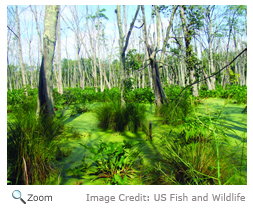 Swamps are forested wetlands. Like marshes, they are often found near rivers or lakes and have mineral soil that drains very slowly. Unlike marshes, they have trees and bushes. They may have water in them for the whole year or for only part of the year. Swamps vary in size and type. Some swamps have soil that is nutrient rich, other swamps have nutrient poor soil. Swamps are often classified by the types of trees that grow in them. Swamps are forested wetlands. Like marshes, they are often found near rivers or lakes and have mineral soil that drains very slowly. Unlike marshes, they have trees and bushes. They may have water in them for the whole year or for only part of the year. Swamps vary in size and type. Some swamps have soil that is nutrient rich, other swamps have nutrient poor soil. Swamps are often classified by the types of trees that grow in them.
Conifer Swamps
Trees like white cedar, northern white cedar, eastern hemlock, eastern white pine, pitch pine, loblolly pine and black spruce are common in conifer swamps.
Hardwood Swamps
Hardwood swamps have trees like red maple,
black willow, aspen, cottonwood, ashes, elms, swamp white oak, pin oak, tupelo and birches.
Shrub Swamps
Shrub swamps have small trees and bushes
like buttonwood, willow, alders and dogwood.
Cypress Swamps
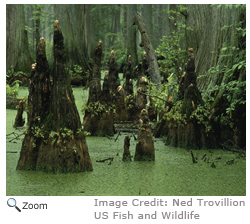 Cypress
swamps are found in the southern United States. They are named for the bald cypress tree. Bald cypress trees are deciduous trees with needle-like leaves. They have very wide bases and "knees" that grow from their roots and stick up out of the water. Bald cypress trees can grow to 100 to 120 feet tall. Cypress
swamps are found in the southern United States. They are named for the bald cypress tree. Bald cypress trees are deciduous trees with needle-like leaves. They have very wide bases and "knees" that grow from their roots and stick up out of the water. Bald cypress trees can grow to 100 to 120 feet tall.
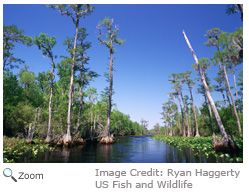 Fire plays an important role in the establishment of bald cypress swamps. Cypress trees grow very quickly after a fire and re-establish themselves before other trees have a chance to grow! Fire plays an important role in the establishment of bald cypress swamps. Cypress trees grow very quickly after a fire and re-establish themselves before other trees have a chance to grow!
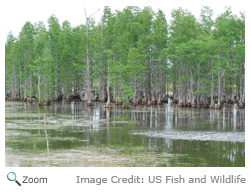 Many of the bald cypress trees in cypress swamps in the U.S. were cut down in the late 1800s and the early 1900s. The wood from the bald cypress is resistant to rot and was a popular wood for building. Other trees and shrubs like pond cypress, blackgum, red maple, wax myrtle, and buttonwood can also be found in cypress swamps. Animals like white-tailed deer, minks, raccoons, anhingas, pileated woodpeckers, purple gallinules, egrets, herons, alligators, frogs, turtles and snakes are often found in cypress swamps. Many of the bald cypress trees in cypress swamps in the U.S. were cut down in the late 1800s and the early 1900s. The wood from the bald cypress is resistant to rot and was a popular wood for building. Other trees and shrubs like pond cypress, blackgum, red maple, wax myrtle, and buttonwood can also be found in cypress swamps. Animals like white-tailed deer, minks, raccoons, anhingas, pileated woodpeckers, purple gallinules, egrets, herons, alligators, frogs, turtles and snakes are often found in cypress swamps.
|
|
From
Lake to Swamp
Swamps start out as lakes, ponds or other shallow bodies of water. Over time, trees and shrubs begin to fill in the land. Plants die and decay and the level of the water gets lower and lower. Eventually, the original body of water becomes a swamp.
The Great Dismal Swamp
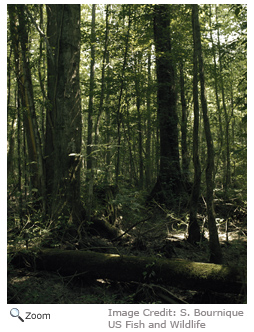 The Great Dismal Swamp is located in northeastern North Carolina and southern Virginia. It is a mixture of waterways, swamps and marshes. Unlike most swamps, it is not located near a river. It is a coastal plain swamp. Trees like cypress, black gum, juniper, and water ash are common. Animals commonly found in the Great Dismal Swamp include black bears, white-tailed deer, opossum, raccoons, cottonmouth snakes. The Great Dismal Swamp is located in northeastern North Carolina and southern Virginia. It is a mixture of waterways, swamps and marshes. Unlike most swamps, it is not located near a river. It is a coastal plain swamp. Trees like cypress, black gum, juniper, and water ash are common. Animals commonly found in the Great Dismal Swamp include black bears, white-tailed deer, opossum, raccoons, cottonmouth snakes.
Okefenokee Swamp
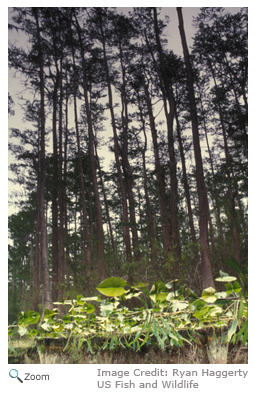 The Okefenokee Swamp is located in southeastern Georgia and northern Florida. It is about 25 miles wide and 40 miles long. Not all of the Okefenokee is a swamp, part of it is a bog. In fact, Okefenokee is an Indian word that means "Land of the Trembling Earth." Parts of the swamp are so boggy that you can shake the trees by stomping on the ground! The Okefenokee Swamp is located in southeastern Georgia and northern Florida. It is about 25 miles wide and 40 miles long. Not all of the Okefenokee is a swamp, part of it is a bog. In fact, Okefenokee is an Indian word that means "Land of the Trembling Earth." Parts of the swamp are so boggy that you can shake the trees by stomping on the ground!
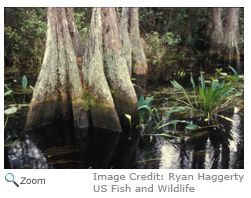 Trees in the Okefenokee swamp include giant tupelo and bald cypress. Mammals like the raccoon, black bear, white-tailed deer, bobcats, red fox and river otter make the swamp their home. Reptiles in the swamp include the eastern diamondback rattlesnake, cottonmouth, eastern coral snake, copper head, alligator and snapping turtle. Birds like the barred owl, anhinga, great egret, great blue heron and sandhill crane are also found in the swamp. Plants like the pitcher plant, water lily and spanish moss that grow in the swamp can survive in the nutrient poor soil and acidic soil of the Okefenokee swamp. Trees in the Okefenokee swamp include giant tupelo and bald cypress. Mammals like the raccoon, black bear, white-tailed deer, bobcats, red fox and river otter make the swamp their home. Reptiles in the swamp include the eastern diamondback rattlesnake, cottonmouth, eastern coral snake, copper head, alligator and snapping turtle. Birds like the barred owl, anhinga, great egret, great blue heron and sandhill crane are also found in the swamp. Plants like the pitcher plant, water lily and spanish moss that grow in the swamp can survive in the nutrient poor soil and acidic soil of the Okefenokee swamp.
|







